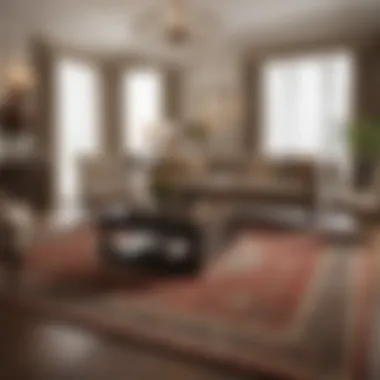Elevating Living Spaces with Luxurious Area Rugs


Intro
Area rugs hold a unique position in living room design, offering both aesthetic appeal and practical benefits. They serve as foundations that tie together furnishings and decor, reflecting personal style while enhancing comfort. Choosing the right area rug can elevate any space, ensuring it resonates with the sophistication desired by discerning homeowners. In this exploration, we will delve into the integral role area rugs play in design, styles and materials available, as well as strategic placement tips. This guide ensures readers gain valuable insights into transforming their living rooms into luxurious retreats that inspire relaxation and elegance.
Outdoor Decor Ideas
Even though the focus is on living room design, outdoor spaces cannot be ignored. Elegant outdoor decor contributes to an overall atmosphere of a luxurious home. Consider how an area rug can create a cohesive environment between indoor and outdoor spaces. Here are some ideas to merge these realms:
- Textured Rugs: Weather-resistant area rugs made from synthetic fibers are perfect for patios or balconies. They can enhance the outdoor lounge areas remarkably.
- Color Coordination: Choose colors that complement the interior. This approach creates a seamless transition when viewing both indoor and outdoor spaces.
- Layering Textures: Use various patterns in rugs while keeping in mind cohesion. Mix and match different surface textures to elicit visual interest.
- Functional Layouts: Arrange outdoor furniture in a manner that benefits utility. An area rug can denote a social zone and influence conversation flow among guests.
Using these specific decor ideas allows homeowners to enhance their living spaces effectively.
Seasonal Inspirations
Rugs can significantly affect the ambiance seasonally. During winter—many choose brighter, warmer colors while selecting soft and cozy options. In contrast, summer might call for more minimalistic and refreshing rug styles. Be adaptable ensuring rugs reflect the mood of seasons:
- Choose rugs that evoke warmth in the winter months.
- Select cool-toned fibers, making your space feel fresh and airy in summer.
Understanding seasonal sensitivities reinforces the impact of area rugs in establishing a shifting atmosphere in the living room.
Furniture Selection
When coordinated well, furniture and rugs complement each other fundamentally. Careful selection of size, pattern, and color leads to a harmonious design. Pay attention to these key points:
- Scale and Proportion: Always consider the dimensions of the area rug relative to the furniture. Ideally, for seating areas, all furniture legs should touch the rug, creating a unified look.
- Color Harmony: The hues in your area rug should echo or soften the tones around it. Noticing color balance enhances design impact.
Each choice contributes to the framework guiding how a living room’s visual narrative unfolds.
Decorative Lighting
Area rugs can enhance how light interacts with your space, creating an inviting ambiance. The material of the rug plays a role in light reflection. Combining different lighting layers—task, ambient, and accent—works together with rug placement:
- Layered Lighting: Incorporate chandeliers, table lamps, and sconces that suit the design, preserving coordination with your fancy area rugs.
- Soften Brightness: Depending on the rug fabric, a softer rug might diffuse brighter light, achieving a gentle atmosphere.
Favor lighting solutions that accentuate architectural features of rugs and captivates elegance overall.
Synthesis
In summary, when strategically utilized correctly, area rugs can significantly elevate living spaces. The tips and ideas represent key steps homeowners can take in crafting luxurious and distinguished interiors. With consideration towards outdoor elements, seasonal responsiveness, calculated furniture choices, and harmonious lighting, the practical and cohesive roles of area rugs are amplified.
Encouraging sophistication, the design process should allow space for individual personality through these easily-implementable suggestions. Achieving cohesiveness can lead to sophisticated surroundings helping to breathe new life and elegance into luxurious living rooms.
Preamble to Area Rugs in Living Rooms
Area rugs play a significant role in the design and functionality of living rooms. They do more than simply add a decorative touch; their impact goes beyond aesthetics. In contemporary decor, an area rug is considered essential. Their presence can unify disparate elements in a room, providing harmony and balance.
One key benefit of area rugs is their ability to define spaces. In open-plan designs, a rug can visually separate different areas, such as the living room from the dining space. This delineation creates a sense of organization amid potential chaos, bringing a level of elegance to the arrangement.
Additionally, area rugs offer a grounding effect. They draw the eye to specific focal points, such as a coffee table or a seating arrangement. Their size, shape, and positioning within the room contribute to the overall flow and movement.
Considerations for choosing area rugs include material, size, and style. Each aspect has implications for design coherence and functionality. For example, a large, plush area rug amplifies comfort while maintaining a sophisticated appeal. Additionally, materials should be selected based on durability and cleaning ease, particularly in high-traffic areas.
In summary, area rugs serve as a vital element in living room design. Their importance lies not only in stylistic choices but also in their ability to foster comfort, organization, and visual appeal. To experience the complete benefits a well-chosen area rug can bring, one must carefully consider the elements that synergize within the specific space.
The Aesthetic Appeal of Area Rugs
The aesthetic value of area rugs serves as a focal point in living room design. They do more than simply common floor coverings; they add character and depth to a space. Choosing the right rug can dramatically influence the overall feel of the room. Area rugs can establish a cohesive look, tying together furniture and decor while providing visual balance.
When one deliberates over decor choices, area rugs frequently play an understated yet pivotal role in elevating the breadth of style and sophistication in residential settings. The careful selection of colors, patterns, and textures can transform a dull area into a high-impact environment, making the space appealing both day and night. This importance cannot be overstated for individuals raising their living space condition.
Visual Anchoring and Focus
Area rugs are often instrumental in visually anchoring a room. They define spaces, contrasting loudly against hard flooring, leading the eye toward a particular area. Indeed, a well-placed rug effectively maps out the flow of movement throughout a living area. Anyone glancing across such spaces will begin to understand how a rug can delineate different functions seamlessly; lounging, dining, or even reading nooks gain purpose offered by area rugs.
This positioning empowers the decision-maker to curate homely yet dynamic looks. As discerning designers recognize, utilizing rugs serves a dual prupose; they can also complement furniture, thus elevating the surroundings. To grasp the significance of visual anchoring, consider:


- Shape and Size: Minimalist, clever designs focus on angular movements while expansive layouts invite fluid journeys across space.
- Material Choice: The texture contributes consideration. Plush textures contributed to areas designated relaxation can lend a different vibration vs. sleek materials, which moreover might prompt formality.
Creating Warmth and Texture
The textural qualities of area rugs lead to surfaces feeling inviting, providing substantial contrast to cold, hard surfaces typically found in many living rooms. Materials promise that redness, softness, or even absorption delight the human senses, inviting connection.
The vibrancy told through color interplay brings forth ambiance shifts suited to client needs such as warmth from wall-to-wall carpets or felts intentionally layered for high-textured bronze looks. Also, varying pile heights on rugs offer multilayers—a sophisticated harmony—all without dominating other design aspects.
By considering color, material, and placement densities, decision-makers create defined personalities for their chosen living environments. This resemblance pleasantly aims to balance sleek high-end interior with cozy familiarity. Subsequently, achieve harmony with individual expressions across refreshing designs in the elevated genres of discriminating tastes.
"An area rug is an invitation – inviting warmth, coziness, and szontric appeal to the entire room."
Combining these elements reinforces the fact that rugs anchor a visual theme while providing sensory comfort delivered through choice proposition. The aesthetic appeal encapsulated gives grace to interior decor while preserving luxury and cohesion with expansive possibilities.
Types of Area Rugs for Living Rooms
When discussing living room design, the choice of area rugs cannot be underestimated. Area rugs serve both practical and aesthetic purposes. They can define spaces, add warmth, and contribute greatly to the overall ambiance of a room. Understanding the various types of area rugs available helps in making informed decisions about design choices that align with individual preferences and needs. The right selection can elevat your living surroundings significantly.
Woven Rugs
Woven rugs represent a traditional and skilled craft. These rugs are created by interlacing threads, usually of wool, cotton, or synthetic material. The result is a fabric that is durable yet soft. Woven rugs provide not just comfort but also style. They can complement different themes, from rustic to contemporary. Use of color and pattern varies widely, offering options for everyone. These rugs are less prone to wear, making them suitable for high-traffic areas like living rooms. However, they may require occasional cleaning to maintain their appearance. Consider the long-term benefits of selecting a woven rug for a residential oasis.
Tufted Rugs
Tufted rugs are a down-to-earth choice for many homeowners. They are made by punching strands of wool or other fibers into a backing material. This results in a plush surface that is inviting underfoot. One can find tufted rugs in various designs and textures, making them versatile enough for nearly any decor style. They tend to absorb sound well, offering a cozy feel. Unlike woven rugs, tufted rugs may not be as durable and may need careful maintenance. Still, their affordable price makes them desired products for design enthusiasts aiming for a budget-friendly elegance.
Natural Fiber Rugs
Natural fiber rugs provide a unique appeal fresh from nature. They are made from materials such as jute, sisal, or seagrass. These rugs offer an eco-friendly option for those wanting to enhance living spaces without dealing with synthetic products. The texture of natural fiber rugs diversifies a room’s landscape. Often, they come in neutral colors, creating a calming effect. Their durability is a positive trait, but high moisture exposure should be avoided as it can lead to mold or buckling. Weighing the aesthetic appeal against personal practicality is essential when considering natural fiber rugs.
Synthetic Rugs
Synthetic rugs carve their niche in the varieied landscape of interior design. Made from materials like nylon, polyester, or polypropylene, synthetic rugs can withstand significant use. Their moisture resistance makes them easy to maintain, which is a valuable trait for busy lifestyles. Newer advancements in textile technology mean buyers can now choose synthetic rugs that mimic natural fibers. This brings a broader spectrum of textures and designs that cater to both style and function. Look for high-quality synthetic options for the best results, as they can deliver a luxurious feel without high maintenance costs.
In summary, understanding the types of area rugs for living rooms contributes to optimal selection and placement. Each type brings its attributes, making choices diverse and beneficial. Exploring the texture, comfort, and maintenance options ensures that elegant living may be achieved with ease.
Choosing the Right Material for Your Rug
Choosing the right material for an area rug is crucial in the overall design and functionality of a living room. This decision significantly impacts comfort, appearance, maintenance, and durability. Selecting the appropriate material can elevate a space to a whole new level, ensuring that it meets both aesthetic and practical expectations. Understanding different materials will help you make informed choices, adding sophistication and character to your living space.
Wool for Durability and Comfort
Wool rugs are well-known for their exceptional durability and comfort. Made from natural fibers, they resist stains and wear, making them suitable for high-traffic areas. Wool fibers are resilient, meaning the rug can bounce back from heavy furniture placements without noticeable flattening.
Moreover, wool inherently provides warmth. It remains soft to the touch, allowing for comfort underfoot. It has natural insulating properties, helping maintain room temperature during cold months. For those who value a cozy atmosphere, wool rug should consider whatever year.
Key Advantages:
- Stability: Wool rugs maintain shape well over time.
- Insulation: They add warmth both physically and visually to a room.
- Easy Maintenance: Routinely vacuuming can help maintain their condition effectively.
Silk for Luxury and Shine
Silk rugs stand out for their luxury and shine. The smooth texture and radiant finish exhibit sophistication that many other materials cannot match. These rugs are often used as accent pieces, providing elegance and refinement to living spaces.
While silk rugs may require more delicate care, they bring unmatched beauty to any environment. They give a softer feel and typically reflect light beautifully, enhancing a space's ambiance. It is essential to ensure appropriate setting for silk rugs since they may be less durable under heavy use.
Notable Characteristics:
- Aesthetic Appeal: Silk enhances visual interest in design.
- Softness: Provides an elevated tactile experience.
- Light Reflection: The sheen from silk can add depth to decor.
Cotton for Versatility and Ease of Cleaning
Cotton rugs are a popular choice due to their versatility and ease of cleaning. They are lightweight and often come in various designs and colors. Cotton rugs are suitable for any aesthetic theme, from contemporary to classic designs.
Their washable nature is one of the most appealing factors. You can easily maintain cotton rugs through home washing machines. This maintenance is particularly useful for homes with children or pets where spills are more prone to happen.
Advantages of Cotton Rugs:


- Affordable: They offer a cost-effective solution without sacrificing style.
- Variety of Designs: Cotton rugs are available in diverse patterns and colors.
- Easy care: They can easily be cleaned, ideal for occupied spaces.
Choosing the right rug material is vital. Wool, silk, and cotton each brings its unique benefits that can greatly influence the ambiance of a living room.
Color and Pattern Considerations
Color and pattern considerations play a pivotal role in the overall design of living spaces. In the context of area rugs, they not only contribute to the aesthetic appeal of the room but also function as significant design elements that influence the mood and energy of the environment. When selecting an area rug, careful thought regarding colors and patterns ensures harmony with existing decor, enhances room dimensions, and creates focal points that guide the eye. Subtle tones can create tranquility, while vibrant hues energize the space. Additionally, the patterns can either visually expand or contract a space depending on their style and orientation.
Neutral vs.
Bold Colors
The choice between neutral and bold colors is a fundamental decision when incorporating area rugs into living room design. Neutral colors adjacent to a palette of whites, creams, or grays provide a versatile backdrop, allowing for elderly and contrasting decorations to stay prominent. This kind of tonal foundation grants flexibility, permitting seasonal changes in decor or furniture arrangements without overwhelming the space.
Conversely, bold colors, such as deep jewel tones or vibrant primary shades can inject personality into a living room. Using a rich-colored rug commands attention and enforces a strong accent in the design, creating visual arrest. These colors can unify existing furnishings and artistic details. It’s important to note that the balance must be maintained; bold rugs should wisely pair with other less dominant elements to avoid visual chaos.
Geometric vs.
Floral Patterns
Pattern choice—geometry or florals—determines the character of a living room design. Geometric patterns can impart a modern and structured look, often making spaces feel more organized and dynamic. Such patterns easily resonate with contemporary and minimalist styles, achieving a streamlined aesthetic. They can succeed in projecting a sophisticated ambience while accommodating various design elements and room layouts.
On the other hand, floral patterns introduce a softer, more classic appeal to an area rug. These motifs can invoke a sense of coziness and warmth, often harmonizing effortlessly with traditional or vintage decor styles. Likewise, floral patterns can create an organic rhythm in the room that witnesses a continuity to an outdoor environment, enhancing a calm atmosphere suitable for relaxation.
The coalescence of these colors and patterns offers a unique opportunity to tailor a living space that speaks to personal taste while integrating well with existing furnishings and architectural features.
Ultimately, the choice of color and pattern for area rugs should speak distinctly to the affinities of the occupants but also harmonize with the functional design of the living room. With right selections, an area rug becomes not merely a floor covering but an integral part of the living room, affecting both likeness and usability.
Size and Placement of Area Rugs
The size and placement of area rugs carry considerable weight in living room design. Getting these two elements right can enhance visual conveying and affect the room’s functionality. The wrong size could make a space feel cramped or disproportionate. Likewise, improper placement obscures the intended impact of style and function. Understanding these variables guides choices that achieve a harmonious aesthetic while fortifying the welcoming nature of the living area.
Finding the Right Size
Choosing the right size for your area rug depends on a mix of the room’s dimensions and furniture layout. Generally, one rule of thumb is ensuring the rug is large enough so that at least the front legs of major furniture pieces rest upon it. This gives a unified look that ties elements together and creates a focused space.
Important considerations include:
- Room Dimension: Measure the area where you intend to place the rug to ensure balance and proportion.
- Furniture Arrangement: Assess your furniture layout to see how the rug can connect different zones within the room.
- Rug Shapes: Rectangular rugs also tend to work well in rectangular spaces while round rugs soften angles and might work better in intimate settings.
For example, if a living room measures 16 x 20 feet, a common size for the rug could be 9 x 12 feet. Avoid too-small rugs since they break visual continuity and can make space lose essential focusing points.
Placement Tips for Optimal Impact
Once the proper size is undestood, consider these practical placement tips:
- Define Spaces: Use rugs to demarcate different areas, especially in open-plan living. For example, a rug can distinguish the seating area from a dining section.
- Center under Coffee Table: A common strategy is to place the rug underneath the coffee table’s center, anchoring it in the overall space. This orientation enhances utility while maximizing the visibility of the rug itself.
- Consider Movement Patterns: Arrange rugs with an eye to how movement occurs in the room. Ensure no trip hazards are in high-traffic lines, letting flow infuse the whole area.
A thoughtfully laid out rug creates an appealingly cohesive environment, blending functionality with comfort.
“Area rugs serve as vital design elements that can alter the very essence of living spaces, influencing not only aesthetics but also interactions within those spaces.”
In summary, honing in on the correct sizing and strategic placement will refine the atmosphere of living rooms and allow for their decorative flourishes to shine through efficaciously.
Maintenance and Care for Area Rugs
Keeping area rugs in top condition requires effort and understanding. Proper maintenance not only ensures the longevity of the rug but also preserves the aesthetic of the living space. Regular care protects against dust, dirt, and allergens, which could thrive in the fibers if not addressed. Ignoring maintenance can lead to discoloration and wear, detracting from the luxury ambiance intended in high-end designs.
Regular Cleaning Routines
A consistent cleaning routine is a fundamental aspect of rug maintenance. For day-to-day cleaning, simple vacuuming helps remove dirt and debris that accumulate. It is advisable to use a vacuum cleaner with a suction setting to prevent damaging the fibers.
Every few months, deeper cleaning should be conducted. Depending on the material, this may involve:
- Wool Rugs: Use a gentle wool cleaner. Avoid excessive water.
- Silk Rugs: Seek professional cleaning due to delicacy.
- Synthetic Rugs: These can often be spot cleaned with soap and water.


Additionally, rotating the rug periodically will ensure even wear and fading. It helps in maintaining its original allure. When using upholstery brushes or products, opt for those specified for the rug's material.
Handling Spills and Stains
Spills are inevitable in a living room. The key is to act swiftly to minimize damage. Start with blottting the spill with a clean, absorbent cloth. Always dab, never rub, to avoid pushing the stain deeper into the fibers. For specific substances:
- Red Wine: Mix white vinegar with water to dab on the area. Then blot with a dry cloth.
- Grease: Use cornstarch or talcum powder to absorb the excess oil; let it sit and then vacuum.
- Coffee: A solution of a few drops of dish soap and water applied gently can help.
If the stain persists, consider consulting professional cleaners specializing in area rugs. Regular maintenance combined with prompt attention to spills ensures that these investments remain vibrant and essential to the room's design.
Investing in the proper care for your area rugs can significantly enhance both their aesthetic appeal and durability, contributing to a sophisticated living environment.
Incorporating Area Rugs with Other Design Elements
In the world of interior design, area rugs transcend their utilitarian role to become pivotal elements in creating cohesive living spaces. By thoughtfully incorporating rugs with other design components, homeowners can significantly enhance the aesthetic and functional quality of their environments. The careful selection of rugs that resonate with existing furniture styles and textures not only elevates the room’s appearance but fosters an enriching visual experience. This section will delve into specific methods for effectively integrating area rugs, ensuring they harmonize beautifully with various features of living room decor.
Complementing Furniture Styles
When choosing an area rug, it is essential to consider the furniture styles present in the living space. An area rug can act as a unifying agent that connects disparate furniture pieces. For instance, a contemporary rug can complement a modern sofa's sleek lines, while a traditional pattern may better suit classic wooden furnishings. The key is to recognize the shared characteristics among the different styles within the room and select a rug that balances these elements. Options include:
- Color Palette: Layering rugs in colors found within furniture cushions or upholstery creates a seamless transition across planes.
- Shape and Design: A round rug can soften angular furniture, while a rectangular rug can help visually elongate a space dominated by long furniture pieces.
- Material Coherence: Materials such as leather, linen, or velvet in the furniture can inspire the choice of texture in the rug to maintain consistency.
Taking a measured approach to align rugs with furniture promotes a more polished look without overpowering any singular element. It is prudent to invest time in visualizing diverse combinations before making a final selection.
Balancing Textures within the Room
Texture plays a fundamental role in home design and is critical in establishing a sense of comfort and luxury. The incorporation of area rugs should also take into account the varied textures present in the living space. When executed effectively, this can promote elegance and depth in the overall design. To create a harmonious ambiance, consider the following:
- Layered Textures: Mixing different fabric types adds dimension and interest to the visual landscape. For instance, pairing a thick pile shag rug with sleek leather or glass furniture creates striking contrast.
- Tactile Elements: Since tactility impacts the comfort of a space, it is smart to coordinate the rug texture with other items such as throw pillows or blankets. These complementary layers deepen interest and refresh a room.
- Visually Interesting Combinations: Using a vintage rug in a prominently modern environment can draw the eye, making the space appear curated and thoughtful without overwhelming the unifying modern aesthetic.
From subtlty to bold statements, balancing various textures not only adds visual allure, but it also enriches the tactile experience of the space, making it truly inviting yet sophisticated.
By mindfully integrating a suitable rug design with existing furniture styles and balancing textures, one can really maximize the impact of area rugs in any living room formation. Each design choice fosters a warmth that conjures sophistication irrespective of style preferences, melding utility with artistry effortlessly.
Showcasing Inspirational Living Room Designs
The significance of showcasing inspirational living room designs lies in their ability to influence and guide those interested in luxury interior decorating. Area rugs are key components in defining the ambiance and function of a space. By analyzing curated examples, one can illustrate how area rugs serve not merely as decoration but as fundamental factors in the overall design narrative. The styles discussed here carry specific elements, benefits, and considerations that elevate living rooms into sophisticated experiences.
Modern Minimalist Spaces
In modern minimalist settings, every piece has a purpose. Area rugs provide a defining element, anchoring furniture while maintaining the clean lines typical of this aesthetic. Choosing neutral tones like whites, greys, or blacks complements the simplicity of the minimalist theme. Think about a light gray wool rug under a low-profile sofa, creating a contrast without overwhelming the space. Minimalist designs prioritize open spaces, so the rug's scale must fit carefully, allowing for visual flow. For added interest, subtle textures can be introduced through the rug’s material, promoting a sense of warmth while remaining restrained.
Classic Elegance
Classic elegance often blends traditional furnishings with luxurious decor. In this context, area rugs play a vital role. Opting for richly patterned rugs made from natural fibers like silk or wool can enhance the sophistication of the room. Imagine a Persian rug radiating beneath a mahogany coffee table, providing historical context and depth to the overall design. Colors such as deep reds, navy blues, and gold can bring about a regal tone. Overlaying delicate, ornate design details with high-end furniture allows for moments of opulence while emphasizing textures and ornate architecture, leaving unforgettable impressions on guests.
Eclectic Styles
Eclectic styles focus on differing design elements harmoniously blended within a living space. Area rugs serve as a unifying factor amidst diverse materials and patterns. The choice of a bold patterned rug can instigate visual interest in a room encompassed with various textures. Mixing elemental styles brings out personal creativity. An oversized area rug featuring a colorful abstract design under mismatched furniture can create focal points, stimulating conversation. Elements like vintage furnishings combined with contemporary art pieces amplify this approach. Detailed layering, using rugs from different cultures, fosters rich narratives, translating them into distinct storytelling experiences without alienating the ambiance.
"An area rug transforms a living room from a mere gathering space into a curated display of personal style."
End: Enhancing Luxury Living with Area Rugs
The role of area rugs in achieving luxurious living rooms cannot be understated. This article explored many aspects of area rugs, from their aesthetic sensibilities to practical considerations. When incorporated thoughtfully, area rugs can transform the mood of a entire space while elevating its style.
Importance of Area Rugs
Area rugs serve multiple purposes. First, they add visual interest and help define spaces within open-concept layouts. Second, they contribute to the comfort of the room by providing a soft surface underfoot. In terms of aesthetics, a well-chosen rug can enhance the color palette of a room, creating harmony amongst decor pieces. Their patterns can introduce dynamics, balancing elegance with personal intricacies.
Benefits of Integrating Rugs
- Comfort: Area rugs create a warm and inviting environment. Walking barefoot on them leads to a more cozy living room experience.
- Acoustic Control: Rugs can help with sound absorption, minimizing echo within a space. They subtly contribute to a tranquil atmosphere.
- Design Flexibility: Different styles of rugs pair well with various furniture aesthetics. This versatility allows to tailor spaces that reflect individual tastes.
Considerations When Choosing Rugs
While the benefits are clear, selecting the right rug interplay with the rest of the decor is essential. The size, material, color, and pattern are determinants of both function and style. Each choice should consider how it contributes to the overall ambiance and practicality.
"A luxurious living space is not only defined by its furniture but how well those elements coexist and complement each other.'
End
In summary, area rugs can significantly influence both the appearance and purpose of living rooms. Their thoughtful integration enhances elegance and boosts overall luxury while fulfilling accounts of comfort and acoustics. By acknowledging their potential and making informed selections, one can genuinely uplift living spaces to new heights.







